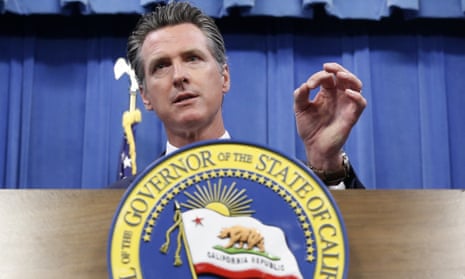Cities and counties in California will be allowed to create their own public banks, making the state one of just two to legalize institutions of that kind.
The California governor, Gavin Newsom, on Wednesday signed the Public Banking Act, or AB 857, which will allow city and county governments to create, or sponsor, public banks. Those banks will in turn provide public agencies access to loans at interest rates much lower than they could find at private banks.
Supporters say the change sets the stage for funding infrastructure demands or providing loans to developers to help meet affordable housing needs.
Assemblyman David Chiu, who co-authored the legislation with assemblyman Miguel Santiago, said the bill’s “signing sends a strong message that California is putting people before Wall Street profits”.
The Democratic congresswoman Alexandria Ocasio-Cortez tweeted her support on Wednesday after Newsom signed the bill, writing: “Public banking is next level!”
Wow. Congratulations to the California grassroots for this enormous victory. Kudos to @GavinNewsom for signing this.
— Alexandria Ocasio-Cortez (@AOC) October 3, 2019
Public banking is next level! #PeopleOverProfit https://t.co/Hxjl7FF8xn
Public banks have existed for 100 years, originating in North Dakota where low population density made it both difficult for financial institutions to grow and loans tough to come by. In 1919, the Bank of North Dakota was born, which today is the nation’s only public bank.
Supporters say public banks benefit local communities because they aren’t driven to seek ever-higher profits, allowing government agencies access to low-interest loans for projects that benefit the public. As they do in North Dakota, public banks in California would also partner with private banks to offer loans to businesses and students.
In California, calls for public banks intensified after the financial collapse of 2008. The crisis increased demands for divestment in banks such as Wells Fargo and major financial institutions tied to the Dakota Access pipeline and other controversial projects, said Sushil Jacob, a senior attorney with the Lawyers’ Committee for Civil Rights of the San Francisco Bay area.
Jacob’s organization is a founding member of the California Public Banking Alliance, a grassroots network of groups in cities that campaigned for the bill including San Francisco, Oakland and San Diego. Jacob points to North Dakota as evidence of the effectiveness of public banks.
“The state of North Dakota has six times as many financial institutions per capita as the rest of the country and it’s because they have the Bank of North Dakota. When the great recession hit, the Bank of North Dakota stepped in and provided loans and allowed local banks to thrive,” Jacobs said.
Critics of public banks said that it sets the stage for public corruption and self-dealing.
“We are disappointed that the governor signed AB 857 into law today. Despite the rhetoric from public bank advocates, Californians are not clamoring for a public bank option,” the California Bankers Association said in statement. “[We] hope that community leaders and elected officials will take note of the risks associated with establishing a municipal bank, before opting to explore this unnecessary and unwanted public option,” it added.
“We don’t think the government should be in the business of banking,” Stuart Waldman, president of the Valley Industry & Commerce Association, a business advocacy group in the San Fernando Valley that opposed the bill, told the Los Angeles Times. He pointed to the department of motor vehicles as an example of the government’s inefficiency.
Jacob said the public banks in California would be operated by professional bankers and run by an independent board of directors to insulate and protect against self-dealing.
The bank’s sponsor would have to propose a viable business plan which would need to be approved by the state department of business oversight and would also need approval to obtain direct deposit insurance from the Federal Deposit Insurance Corporation. The plan would have to go before the public before it moved forward.
“That injects an element of sunshine and public debate,” said Jacobs, who added that because the banks would be public entities, they would be subject to laws that require them to provide the public access to records and meetings. “There are a lot of protections, far more than the current structure (of private banks).”
The law allows the state to license no more than two public banks per calendar year and caps the total number at 10.
Nearly two dozen other states – including four this year – have also tried to establish public banks, according to Vox. None of the other bills have passed.
